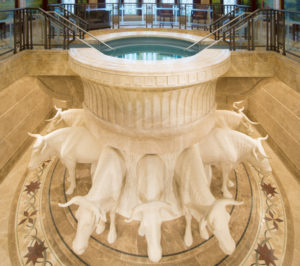Paul Derengowski, ThM
In case you missed it, the Mormons are building another temple or are at least planning on building one, this time in India; the home of multiple pagan temples and shrines.
That one, along with several others already in progress or on the drawing board, brings the total number to around 180 Mormon Temples worldwide.
What makes the announcement less than transparent is the fact that very few people actually know what goes on in a Mormon Temple, once it is closed to the public.
Prior to its closing, the general public is allowed to tour its hallways and meeting rooms, all of which are elaborately and ornately decorated.
Then, after access it completely cut off, it is on with the pagan rituals, which includes the ever-changing Endowment Ceremony and the occult baptisms for the dead.
The Endowment Ceremony is for the special Mormon, who has obeyed all the ordinances and prescriptions of the Mormon leadership and now wishes to be “sealed” to his equally special Mormon partner for “time and eternity.”
[wonderplugin_video videotype=”mp4″ mp4=”https://capro.info/wp-content/uploads/Mormonism/Temple_Endowment_Ceremony.mp4″ videowidth=600 videoheight=400 keepaspectratio=1 videocss=”position:relative;display:block;background-color:#000;overflow:hidden;max-width:100%;margin:0 auto;” playbutton=”https://capro.info/wp-content/plugins/wonderplugin-videoembed/engine/playvideo-64-64-0.png”]
Secret names and handshakes are exchanged, along with the expectation that if both the husband and wife can endure to the end of their lives—and the husband calls for his wife from the grave one day—then they can go on to become a god and goddess, populating and governing their own planet somewhere in the cosmos.
Baptism for the dead, on the other hand, is based on the notion which projects that salvation is predicated on fallen humanity’s “free choice” to choose between eternal life and death.
Since some men and women—perhaps even a majority—will never hear the gospel in their natural lifetime, whereby then can be saved through baptismal regeneration, then it is incumbent upon Mormon church members to provide those options through proxy baptism, posthumously.
Then, “Missionaries from paradise visit prison,” where all the non-Mormon, deceased reside, “to teach the gospel.”
“After the spirits in prison accept the gospel and the ordinances performed for them in the temples, they may prepare themselves to leave the spirit prison and dwell in paradise” (Gospel Principles 1981:280).
Some of those rejuvenated individuals—like Adolf Hitler and Eva Braun, both of whom have been proxy baptized and seal by Mormon zealots—may even strive hard enough to become gods and goddesses themselves.
Surely the 330,000,000 gods and goddesses of Hindu folklore must be proud.
Mormon President Russell Nelson opined, “The influence of the temple will be felt not only by the people here in this particular part of India, but it will bless the people of the entire nation and neighboring nations.”
The reality is, building another pagan temple in the midst of all the other pagan temples and shrines in India will not be a “blessing.” Instead, it will be a blight.
Thankfully, in recent years the Mormon blight has been mitigated through ready access of information on the Internet.
Here’s hoping that India’s people will see beyond all the Mormon temple eye candy and discern that what Mormonism has to offer is as hopeless as believing in Vishnu, Buddha, reincarnation, or karma.





